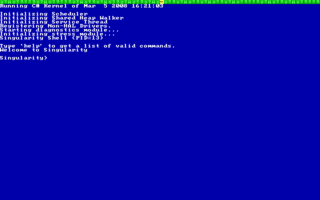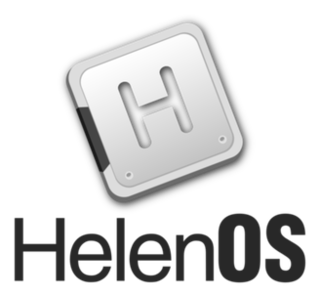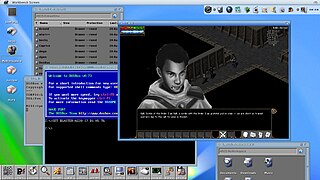Mach is a kernel developed at Carnegie Mellon University to support operating system research, primarily distributed and parallel computing. Mach is often mentioned as one of the earliest examples of a microkernel. However, not all versions of Mach are microkernels. Mach's derivatives are the basis of the modern operating system kernels in GNU Hurd and Apple's operating systems macOS, iOS, tvOS, and watchOS.
OS-9 is a family of real-time, process-based, multitasking, multi-user operating systems, developed in the 1980s, originally by Microware Systems Corporation for the Motorola 6809 microprocessor. It was purchased by Radisys Corp in 2001, and was purchased again in 2013 by its current owner Microware LP.

QNX is a commercial Unix-like real-time operating system, aimed primarily at the embedded systems market. The product was originally developed in the early 1980s by Canadian company Quantum Software Systems, later renamed QNX Software Systems and ultimately acquired by BlackBerry in 2010. QNX was one of the first commercially successful microkernel operating systems and is used in a variety of devices including cars and mobile phones.

UAE is a computer emulator which emulates the hardware of Commodore International's Amiga range of computers. Released under the GNU General Public License, UAE is free software.

XNU is the computer operating system kernel developed at Apple Inc. since December 1996 for use in the macOS operating system and released as free and open-source software as part of the Darwin operating system. It is also used as the kernel for the Apple TV Software, iOS, watchOS, tvOS, and audioOS operating systems. XNU is an abbreviation of X is Not Unix.

Singularity is an experimental operating system (OS) which was built by Microsoft Research between 2003 and 2010. It was designed as a high dependability OS in which the kernel, device drivers, and application software were all written in managed code. Internal security uses type safety instead of hardware memory protection.

Phase5 Digital Products is a defunct German computer hardware manufacturer that developed third-party hardware primarily for the Amiga platform. Their most popular products included CPU upgrade boards, SCSI controllers and graphics cards.

HelenOS is an operating system based on a multiserver microkernel design. The source code of HelenOS is written in C and published under a BSD License.
The Amiga computer can be used to emulate several other computer platforms, including legacy platforms such as the Commodore 64, and its contemporary rivals such as the IBM PC and the Macintosh.
A hybrid kernel is an operating system kernel architecture that attempts to combine aspects and benefits of microkernel and monolithic kernel architectures used in computer operating systems.

AROS Research Operating System is a free and open-source multi media centric implementation of the AmigaOS 3.1 APIs. Designed to be portable and flexible, ports are currently available for x86-based and PowerPC-based PCs in native and hosted flavors, with other architectures in development. AROS, in a show of full circle, was also ported to the m68k-based Amiga 1200, and there's also an ARM port for the Raspberry Pi series.
The Mac OS nanokernel is an extremely simple operating system kernel serving as the basis of most PowerPC based system software versions 7 through 9 of the classic Mac OS, predating Mac OS X.
TI-RTOS is an embedded tools ecosystem created and offered by Texas Instruments (TI) for use in a wide range of their embedded processors. It includes a real time operating system component called "TI-RTOS Kernel" along with additional components that support device drivers, networking connectivity stacks, power management, file systems, instrumentation, and inter-processor communications like DSP/BIOS Link.
WarpOS is a multi-tasking kernel for the PowerPC architecture developed by Haage & Partner for the Amiga computer platform in the late 1990s and early 2000s. It runs on PowerUP accelerator boards developed by phase5 which contains both a Motorola 68000 family CPU and a PowerPC CPU with shared address space. WarpOS runs alongside the 68k-based AmigaOS, which can use the PowerPC as a coprocessor. Despite its name, it is not an operating system (OS), but a kernel; it supplies a limited set of functions similar to those in AmigaOS for using the PowerPC. When released its original name was WarpUP, but was changed to reflect its greater feature set, and possibly to avoid comparison with its competitor, PowerUP.

AmigaOS is a family of proprietary native operating systems of the Amiga and AmigaOne personal computers. It was developed first by Commodore International and introduced with the launch of the first Amiga, the Amiga 1000, in 1985. Early versions of AmigaOS required the Motorola 68000 series of 16-bit and 32-bit microprocessors. Later versions were developed by Haage & Partner and then Hyperion Entertainment. A PowerPC microprocessor is required for the most recent release, AmigaOS 4.

PowerUP boards were dual-processor 68k–PowerPC accelerator boards designed by Phase5 Digital Products for Amiga computers. They had two different processors working in parallel, sharing the complete address space of the Amiga computer system.

A new version of AmigaOS was released on December 24, 2006 after five years of development by Hyperion Entertainment (Belgium) under license from Amiga, Inc. for AmigaOne registered users.















